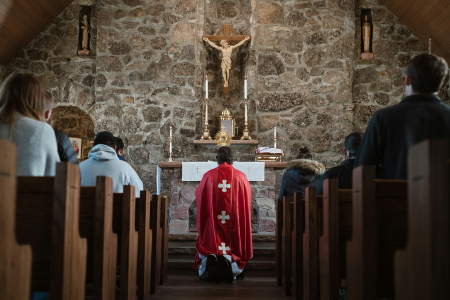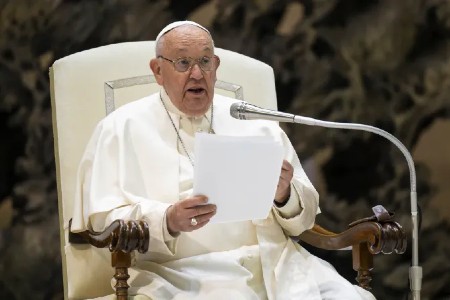Japanese Martyrs
FREE Catholic Classes
There is not in the whole history of the Church a single people who can offer to the admiration of the Christian world annals as glorious, and a martyrology as lengthy, as those of the people of Japan. In January, 1552, St. Francis Xavier had remarked the proselytizing spirit of the early neophytes. "I saw them", he wrote, "rejoicing in our successes, manifesting an ardent zeal to spread the faith and to win over to baptism the pagans they conquered." He foresaw the obstacles that would block the progress of the faith in certain provinces, the absolutism of this or that daimyo , a class at that time very independent of the Mikado and in revolt against his supreme authority. As a matter of fact, in the province of Hirado, where he made a hundred converts, and where six years after him, 600 pagans were baptized in three days, a Christian woman (the proto-martyr) was beheaded for praying before a cross. In 1561 he diamyo forced the Christians to abjure their faith, "but they preferred to abandon all their possessions and live in the Bungo, poor with Christ, rather than rich without Him", wrote a missionary, 11 October, 1562. When, under the Shogunate of Yoshiaki, Ota Nobunaga, supported by Wada Koresama, a Christian, had subdued the greater part of the provinces and had restored monarchical unity, there came to pass what St. Francis Xavier had hoped for. At Miyako (the modern Kiyoto) the faith was recognized and a church built 15 Aug., 1576. Then the faith continued to spread without notable opposition, as the daimyos followed the lead of the Mikado (Ogimachi, 1558-1586) and Ota Nobunaga. The toleration or favor of the central authority brought about everywhere the extension of the Christian religion, and only a few isolated cases of martyrdom are known (Le Catholicisme au Japon, I, 173).
We ask you, humbly: don't scroll away.
Hi readers, it seems you use Catholic Online a lot; that's great! It's a little awkward to ask, but we need your help. If you have already donated, we sincerely thank you. We're not salespeople, but we depend on donations averaging $14.76 and fewer than 1% of readers give. If you donate just $5.00, the price of your coffee, Catholic Online School could keep thriving. Thank you.Help Now >
It was not until 1587, when there were 200,000 Christians in Japan, that an edict of persecution, or rather of prescription, was passed to the surprise of everyone, at the instigation of a bigoted bonze , Nichijoshonin, zealous for the religion of his race. Twenty-six residences and 140 churches were destroyed; the missionaries were condemned to exile, but were clever enough to hide or scatter. They never doubted the constancy of their converts ; they assisted them in secret and in ten years there were 100,000 other converts in Japan. We read of two martyrdoms, one at Takata, the other at Notsuhara; but very many Christians were dispossessed of their goods and reduced to poverty. The first bloody persecution dates from 1597. It is attributed to two causes: (1) Four years earlier some Castilian religious had come from the Philippines and, in spite of the decisions of the Holy See, had joined themselves to the 130 Jesuits who, on account of the delicate situation created by the edict were acting with great caution. In spite of every charitable advice given them, these men set to work in a very indiscreet manner, and violated the terms of the edict even in the capital itself; (2) a Castilian vessel cast by the storm on the coast of Japan was confiscated under the laws then in vigour. Some artillery was found on board, and Japanese susceptibililties were further excited by the lying tales of the pilot, so that the idea went abroad that the Castilians were thinking of annexing the country. A list of all the Christians in Miyado and Osaka was made out, and on 5 Feb., 1597, 26 Christians, among whom were 6 Fransciscan missionaries, were crucified at Nagasaki. Among the 20 native Christians there was one, a child of 13, and another of 12 years. "The astonishing fruit of the generous sacrifice of our 26 martyrs " (wrote a Jesuit missionary) "is that the Christians, recent converts and those of maturer faith, have been confirmed in the faith and hope of eternal salvation ; they have firmly resolved to lay down their lives for the name of Christ. The very pagans who assisted at the martyrdom were struck at seeing the joy of the blessed ones as they suffered on their crosses and the courage with which they met death".
Ten years before this another missionary had foreseen and predicted that "from the courage of the Japanese, aided by the grace of God, it is to be expected that persecution will inaugurate a race for martyrdom ". True it is that the national and religious customs of the people predisposed them to lay down their lives with singular fatalism ; certain of their established usages, religious suicide, hara-kiri , had developed a contempt for death; but if grace does not destroy nature it exalts it, and their fervent charity and love for Christ led the Japanese neophytes to scourgings that the missionaries had to restrain. When this love for Christ had grown strong in the midst of suffering freely chosen, it became easier for the faithful to give the Saviour that greatest proof of love by laying down their lives in a cruel death for His name's sake. "The fifty crosses, ordered for the holy mountain of Nagasaki, multiplied ten or a hundred fold, would not have sufficed" (wrote one missionary) "for all the faithful who longed for martyrdom ". Associations ( Kumi ) were formed under the patronage of the Blessed Virgin with the object of preparing the members by prayer and scourgings even to blood, to be ready to lay down their lives for the faith. After the persecution of 1597, there were isolated cases of martyrdom until 1614, in all about 70. The reigns of Ieyasu, who is better known in Christian annals by the name of Daifu Sama, and of his successors Hidetada and Iemitziu, were the more disastrous. We are not concerned now with the causes of that persecution, which lasted half a century with some brief intervals of peace. According to Mr. Ernest Satow (quoted by Thurston in "The Month", March, 1905, "Japan and Christianity"): "As the Jesuit missionaries conducted themselves with great tact, it is by no means improbable that they might have continued to make converts year by year until the great part of the nation had been brought over to the Catholic religion, had it not been for the rivalry of the missionaries of other orders." These were the Castilian religious; and hence the fear of seeing Spain spread its conquests from the Philippines to Japan. Furthermore the zeal of certain religious Franciscans and Dominicans was wanting in prudence, and led to the persecution.
We ask you, humbly: don't scroll away.
Hi readers, it seems you use Catholic Online a lot; that's great! It's a little awkward to ask, but we need your help. If you have already donated, we sincerely thank you. We're not salespeople, but we depend on donations averaging $14.76 and fewer than 1% of readers give. If you donate just $5.00, the price of your coffee, Catholic Online School could keep thriving. Thank you.Help Now >
Year by year after 1614 the number of marytrdoms was 55, 15, 25, 62, 88, 15, 20. The year 1622 was particularly fruitful in Christian heroes. The Japanese martyrology counts 128 with name, Christian name and place of execution. Before this the four religious orders, Dominicans, Franciscans, Augustinians and Jesuits, had had their martyrs, but on 10 Sept., 1622, 9 Jesuits, 6 Dominicans, 4 Franciscans, and 6 lay Christians were put to death at the stake after witnessing the beheading of about 30 of the faithful. From December until the end of September, 1624, there were 285 martyrs. The English captain, Richard Cocks (Calendar of State Papers: Colonial East Indies, 1617-1621, p. 357) "saw 55 martyred at Miako at one time. . .and among them little children 5 or 6 years old burned in their mother's arms, crying out: ' Jesus receive our souls'. Many more are in prison who look hourly when they shall die, for very few turn pagans ". We cannot go into the details of these horrible slaughters, the skilful tortures of Mount Unaen, the refined cruelty of the trench. After 1627 death grew more and more terrible for the Christians ; in 1627, 123 died, during the years that followed, 65, 79, and 198. Persecution went on unceasingly as long as there were missionaries, and the last of whom we learn were 5 Jesuits and 3 seculars, who suffered the torture of the trench from 25 to 31 March, 1643. The list of martyrs we know of (name, Christian name, and place of execution) has 1648 names. If we add to this group the groups we learn of from the missionaries, or later from the Dutch travellers between 1649 and 1660, the total goes to 3125, and this does not include Christians who were banished, whose property was confiscated, or who died in poverty. A Japanese judge, Arai Hakuseki, bore witness about 1710, that at the close of the reign of Iemitzu (1650) "it was ordered that the converts should all lean on their own staff". At that time an immense number, from 200,000 to 300,000 perished. Without counting the members of Third Orders and Congregations, the Jesuits had, according to the martyrology (Delplace, II, 181-195; 263-275), 55 martyrs, the Franciscans 36, the Dominicans 38, the Augustinians 20. Pius IX and Leo XIII declared worthy of public cult 36 Jesuit martyrs, 25 Franciscans, 21 Dominicans, 5 Augustinians and 107 lay victims. After 1632 it ceased to be possible to obtain reliable data or information which would lead to canonical beatification. When in 1854, Commodore Perry forced an entry to Japan, it was learned that the Christian faith, after two centuries of intolerance, was not dead. In 1865, priests of the foreign Missions found 20,000 Christians practising their religion in secret at Kiushu. Religious liberty was not granted them by Japanese law until 1873. Up to that time in 20 provinces, 3404 had suffered for the faith in exile or in prison ; 660 of these had died, and 1981 returned to their homes. In 1858, 112 Christians, among whom were two chief-baptizers, were put to death by torture. One missionary calculates that in all 1200 died for the faith.
Join the Movement
When you sign up below, you don't just join an email list - you're joining an entire movement for Free world class Catholic education.
-

-
Mysteries of the Rosary
-
St. Faustina Kowalska
-
Litany of the Blessed Virgin Mary
-
Saint of the Day for Wednesday, Oct 4th, 2023
-
Popular Saints
-
St. Francis of Assisi
-
Bible
-
Female / Women Saints
-
7 Morning Prayers you need to get your day started with God
-
Litany of the Blessed Virgin Mary
U.S. Catholic Parishes Experience Resurgence of Traditional Practices
-

Pope Francis Urges Faith and Prayers for Peace
-

Florida Welcomes Volunteer Chaplains to Public Schools
-
10 Fascinating Details About St. Joseph the Worker: Celebrating His Feast Day - May 1
-
St. Joseph the Worker: Model for Men, Young and Old
Daily Catholic
 Daily Readings for Thursday, May 02, 2024
Daily Readings for Thursday, May 02, 2024 St. Athanasius: Saint of the Day for Thursday, May 02, 2024
St. Athanasius: Saint of the Day for Thursday, May 02, 2024 The Our Father: Prayer of the Day for Thursday, May 02, 2024
The Our Father: Prayer of the Day for Thursday, May 02, 2024- Daily Readings for Wednesday, May 01, 2024
- St. Marculf: Saint of the Day for Wednesday, May 01, 2024
- To Saint Peregrine: Prayer of the Day for Wednesday, May 01, 2024
![]()
Copyright 2024 Catholic Online. All materials contained on this site, whether written, audible or visual are the exclusive property of Catholic Online and are protected under U.S. and International copyright laws, © Copyright 2024 Catholic Online. Any unauthorized use, without prior written consent of Catholic Online is strictly forbidden and prohibited.
Catholic Online is a Project of Your Catholic Voice Foundation, a Not-for-Profit Corporation. Your Catholic Voice Foundation has been granted a recognition of tax exemption under Section 501(c)(3) of the Internal Revenue Code. Federal Tax Identification Number: 81-0596847. Your gift is tax-deductible as allowed by law.









 Daily Readings for Thursday, May 02, 2024
Daily Readings for Thursday, May 02, 2024 St. Athanasius: Saint of the Day for Thursday, May 02, 2024
St. Athanasius: Saint of the Day for Thursday, May 02, 2024 The Our Father: Prayer of the Day for Thursday, May 02, 2024
The Our Father: Prayer of the Day for Thursday, May 02, 2024

